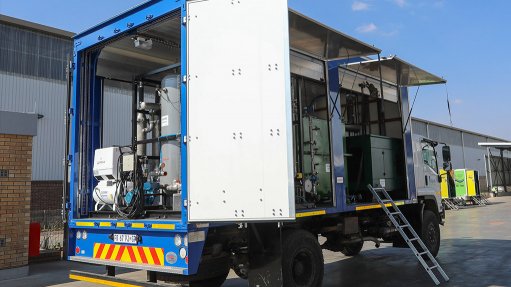
MOBILE WATER TREATMENT PLANT The 4x4 mobile water treatment plant purifies water from any available source for remote communities
The new 6 600 m2 chemical production facility of multinational Veolia Water Technologies South Africa, in Pomona, Kempton Park, is the main blending facility for the company’s local operations, and is also set to export to Veolia’s clients throughout Africa, in view of its competitive costs of production, compared with other Veolia chemical production facilities, such as in Italy and France.
The facility’s production manager, Simon Schmalzried, notes that the factory produces more than 40 chemicals as part of the company’s global Hydrex range of water chemicals, including water and wastewater treatment chemicals, boiler and cooling tower chemicals, flocculant chemicals and reverse-osmosis membrane-cleaning chemicals, as well as specially blended chemicals for specific applications.
The factory produces 500 t of water treatment chemicals a month, which is in line with the capacity of its previous factory in Sebenza, Isando.
However, the factory can increase production to 1 500 t a month if it implements three eight-hour shifts – up from the single shift it currently operates.
“The bottlenecks that became apparent in the previous facility were related to storage capacity, both for the raw materials and the finished products. Here we have sufficient storage space and can triple our production when we need to.”
The factory also has an in- house laboratory for testing and verification, and its testing and quality assurance procedures conform to the International Standards Organisation standards, as well as local standards. It also holds three different food and beverage chemicals certifications, namely the South African Bureau of Standards 1827, 1828 and 1829 standards.
“We are already producing a shipment of chemicals for use in Morocco, and there is a distant opportunity to export to Brazil, where we use toll blenders to produce chemicals for our clients there,” says Veolia South Africa business development manager Chris Braybrooke.
The new production facility complements its Sebenza Engineered Systems facility, where the company’s range of prefabricated packaged plants are built. This includes several key offerings of Veolia’s new Standard Products portfolio, a range of packaged solutions of specific, adapted Veolia products and solutions drawn from its portfolio of over 350 proprietary technologies for particular market segments in Africa, including municipal and industrial water and wastewater treatment.
“The production capacity of the new facility and the demand for our containerised and designed solutions are two central pillars of our Ambitions for Africa initiative. We have large multinational companies that we serve in Africa and are seeing demand for smaller-scale water treatment solutions to serve communities throughout the continent, instead of large, centralised water treatment plants,” he explains.
VeoliaSouth Africa MD Arnaud Gisclon adds that the facility is supportive of its operations in developing countries, but that its production costs allow it to export to developed countries as well. The facility has supplied chemicals to Qatar-based clients.
“All the chemicals conform with our Hydrex manufacturing and chemical blending processes as engineered by our Paris-based research and development division. “Similarly, our focus on environment-friendly chemicals and chemical use, as well as our focus on client service regardless of territory, is also supported by this facility,” he explains.
He adds that, while the company still designs and builds large water treatment plants, demand for smaller, localised solutions has been growing, especially in Africa.
“For the mountainous country of Lesotho, we designed a mobile water treatment plant that fits onto a four-wheel-drive truck. It takes water from any available source and purifies it, through reverse osmosis and chemical dosing, to drinking-water quality, which it discharges into a tank. This tank then serves a small community, often with water piped directly to the houses.”